Archive for the 'Board Game Review' Category
Posted by James (admin) on 27th September 2012
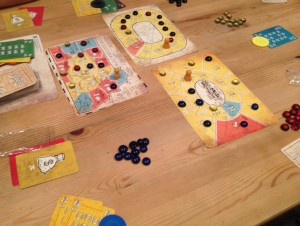 I like the idea of using poker hand mechanics in a game. At Spiel 2011, I played a game that used poker hands but it turned out to be average so I was really intrigued when, just 5 minutes later, I noticed Montana on the Cambridge Games Factory. With a cheap price, I decided to pre-order it and it arrived a couple of months ago.
I like the idea of using poker hand mechanics in a game. At Spiel 2011, I played a game that used poker hands but it turned out to be average so I was really intrigued when, just 5 minutes later, I noticed Montana on the Cambridge Games Factory. With a cheap price, I decided to pre-order it and it arrived a couple of months ago.
Montana is an area control game where players compete for control over 3 areas each round, and the player with the most victory points (VPs) at the end of the game wins. Players score VPs for (a) areas they control with a bonus for having multiple connected regions, (b) if they control their secret objectives, (c) if they control the most red regions, and (d) if they control the most blue regions.
Players start the game with some cards (numbered 1-12 in five colours x 2) as well as two secret objectives (for which they’ll score extra points if they control that specific region). On the table are 3 boards with 16 regions on each. At the start of each turn, one player chooses which region will be contested on the main board (the other two boards are contested in numerical sequence). Read the rest of this entry »
Tags: board game news, Board Games, board gaming, Montana
Posted in Board Game Review, Board Games, Montana | No Comments »
Posted by James (admin) on 25th September 2012
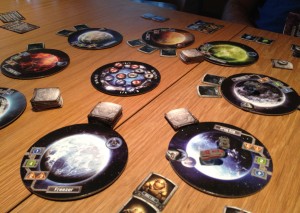 Space Mission is a simple, space-themed game of planetary exploration, but there’s more to it than it first sounds. The goal is to score as many victory points (VPs) as possible which are scored by collecting sets of tiles from the planets and some other ways. On the table are 8 planets each with 8 face-down tiles, and a warp gate in the centre. Each player has a spaceship and starts with a hand of 5 cards. Each card has two numbers on it from 1 to 4 (or a ? which counts as any value) and each number is either green, orange or blue. On their turn, a player can carry out 2 actions (including the same one twice). The 6 actions are:
Space Mission is a simple, space-themed game of planetary exploration, but there’s more to it than it first sounds. The goal is to score as many victory points (VPs) as possible which are scored by collecting sets of tiles from the planets and some other ways. On the table are 8 planets each with 8 face-down tiles, and a warp gate in the centre. Each player has a spaceship and starts with a hand of 5 cards. Each card has two numbers on it from 1 to 4 (or a ? which counts as any value) and each number is either green, orange or blue. On their turn, a player can carry out 2 actions (including the same one twice). The 6 actions are:
- Jump: Discard a card with a blue number and move your spaceship directly to a planet with the same blue number. Place one of your coloured markers on the warp gate.
- Scan: When at an undeveloped planet, discard a card with a green number that matches the planet’s green number to look at that planet’s tiles and reserve one (which you get if the planet gets developed)
- Develop: When at an undeveloped planet, discard two cards with orange numbers that match the planet’s two orange numbers to develop it. Anyone who has scanned and reserved tiles at that planet now receives them, and the developing player takes a tile from the stack too.
- Discover: At any developed planet, take one of the tiles. This action doesn’t cost any cards.
- Fly: Move your spaceship to one of the two planets neighbouring your current location. This action doesn’t cost any cards.
- Draw cards: Discard any cards you want and draw back up to 5 cards. This is the only way to get new cards. Read the rest of this entry »
Tags: board game news, Board Games, board gaming, Space Mission
Posted in Board Game Review, Board Games, Space Mission | No Comments »
Posted by James (admin) on 21st September 2012
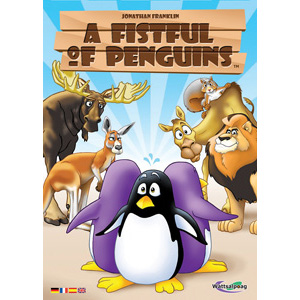 A Fistful of Penguins consists of lots of very cute, clear plastic penguins and some dice which have different animals on each face. On their turn, a player starts by rolling 4-6 dice (depending on which of the 3 rounds it is). After their roll, a player can either (a) stop rolling and cash in their roll, or (b) they can spend one of their penguin pieces to either re-roll any of their rolled dice, or they can roll 1 new dice and add it to their rolled result. Players start with 6 penguins so these options are open to them from the start of the game. Players can keep adding dice and/or re-rolling if they have the penguins to pay for it.
A Fistful of Penguins consists of lots of very cute, clear plastic penguins and some dice which have different animals on each face. On their turn, a player starts by rolling 4-6 dice (depending on which of the 3 rounds it is). After their roll, a player can either (a) stop rolling and cash in their roll, or (b) they can spend one of their penguin pieces to either re-roll any of their rolled dice, or they can roll 1 new dice and add it to their rolled result. Players start with 6 penguins so these options are open to them from the start of the game. Players can keep adding dice and/or re-rolling if they have the penguins to pay for it.
When a player decides to stop rolling, the receive an income based on the various animals they have rolled: Penguins, Lions, Camels, Kangaroos, Squirrels and Moose (1 of each animal on each dice).
- Penguin results earn penguin pieces – you can even cash in dice with penguins on during your turn; however, the more penguins cashed in together, the more penguins the player receives.
- Squirrels mean other players have to give you money in turn order and more squirrels means more money.
- Moose are worth $9 each if they are paired with a squirrel (instead of the normal squirrel effect).
- Kangaroos are worth their total number squared in dollars. If you score kangaroos in the first and/or second round, you get to turn one or two of your dice into kangaroos in the third round.
- Lions are worth $7 each, but if you choose to score lions means only lions and penguins count (and all other animals are worthless).
- Camels are worth $5 each, but $0 if any lions are showing (even if you don’t score them). Read the rest of this entry »
Tags: A Fistful of Penguins, board game news, Board Games, board gaming
Posted in A Fistful of Penguins, Board Game Review, Board Games | 2 Comments »
Posted by James (admin) on 17th September 2012
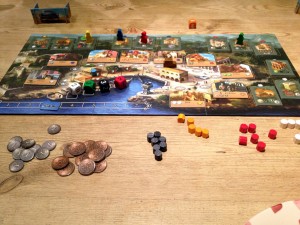 There are some designers that seem to be more stealthy than others – you know, the ones that one day you suddenly notice you’ve got a lot of games by them but never realised it as you acquired them. Michael Rieneck is one of those for me – he’s designed games such as Cuba, Havana, Dracula, Fortuna, Palastgeflüster.
There are some designers that seem to be more stealthy than others – you know, the ones that one day you suddenly notice you’ve got a lot of games by them but never realised it as you acquired them. Michael Rieneck is one of those for me – he’s designed games such as Cuba, Havana, Dracula, Fortuna, Palastgeflüster.
Santiago de Cuba is a hard game to fit into a single genre because it mixes several elements together and does so well. Players earn Victory Points (VPs) by delivering goods (tobacco, sugar, citrus fruit, rum and cigars) to the waiting ship, and the player with the most VPs at the end wins. The board shows a port town with a ring of 9 different Cuban characters and the dock as well. On their turn, a player moves the car piece clockwise around this ring – moving one space forwards is free, but costs 1 peso (cash) for every extra space after that.
Wherever the player stops the car, they get to use the Cuban at that space and then get to use one of the buildings associated with that Cuban; however, it is more clever than it sounds. Most Cubans allow the player to do things like gain resources (tobacco, sugar, citrus fruit, wood), VPs and pesos. Each Cuban has one of 4 coloured roses on their tile too – once the player has used the Cuban’s ability, they must move their playing piece to a building that has the same coloured rose (and that is not occupied by another player). The player can then use that building’s ability such as make rum and cigars from sugar and tobacco, exchange goods, convert rum and cigars into VPs, turn one ship’s demand dice to zero, reduce/extend the time the ship will stay (which dictates the value of any goods delivered), and more. Read the rest of this entry »
Tags: board game news, Board Games, board gaming, Michael Rieneck, Santiago de Cuba
Posted in Board Game Review, Board Games, Santiago de Cuba | No Comments »
Posted by James (admin) on 14th September 2012
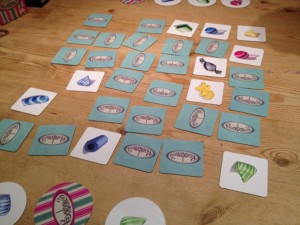 When I was young, I used to play a memory game (like we all probably did) where playing cards were laid out face-down and you turned over 2 of them to try to find a matching pair. I was surprised that Gameworks’ game Bonbons was based on this premise as it seems such a simple game; however, Gameworks have a great track record and I was pleased to find out there was more to it than I expected.
When I was young, I used to play a memory game (like we all probably did) where playing cards were laid out face-down and you turned over 2 of them to try to find a matching pair. I was surprised that Gameworks’ game Bonbons was based on this premise as it seems such a simple game; however, Gameworks have a great track record and I was pleased to find out there was more to it than I expected.
In the centre of the table are 36 face-down sweet/confectionery/candy tiles: there are 32 different sweets (8 types each in 4 colours) plus 3 tiles showing coins, and 1 tile showing an empty wrapper. Each player takes 4 of the 32 round tiles (which show the same sweets as the square tiles) and places these unseen, face-down in front of them. The winner is the first person who has all the round tiles in front of them face-up.
On your turn, you get to turn over 2 tiles (square or round). If you turn over a matching pair (which would be 1 square tile and 1 round tile), they stay face-up. Most importantly, you can turn over an opponent’s round tile and, if you turn over the matching square tile too, you get to place that round tile in front of you and they get one of your face-down round tiles in return. This stealing of other player’s round tiles really adds some fun to the game and it means you’re not just trying to match your own tiles, but are trying to match anyone’s face-down tiles. It’s funny when you steal someone else’s round tile which they’ve been trying to find, but even funnier to see the look on their face when you give them one of your round tiles that hasn’t been turned over at all yet so they’ve spent lots of time and are back to square one. Read the rest of this entry »
Tags: board game news, Board Games, board gaming, Bonbons, GameWorks
Posted in Board Game Review, Board Games, Bon Bons | No Comments »
Posted by James (admin) on 14th September 2012
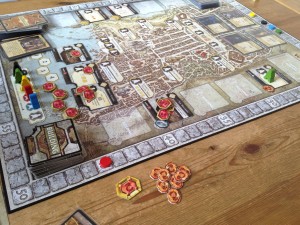 I wasn’t expecting much when Lords of Waterdeep was announced as Dungeons and Dragons-based board games have been pretty lack lustre in the past (the drab Castle Ravenloft being one). However, Lords of Waterdeep is very good with more of a eurogame at its heart.
I wasn’t expecting much when Lords of Waterdeep was announced as Dungeons and Dragons-based board games have been pretty lack lustre in the past (the drab Castle Ravenloft being one). However, Lords of Waterdeep is very good with more of a eurogame at its heart.
During the game, players try to earn as many points as possible by completing their quests. Each quest is completed by sending (spending) the number of adventurers (clerics, rogues, fighters and wizards) shown on the quest, and some quests give the player a special ability too. The main game mechanic is a worker placement game and, on their turn, a player places one of their agents (workers) onto the board and uses the benefit of that location. Locations can give the player adventurers, money, allow them to take a new quest from those on display, build a building (paying resources to do so), etc. One interesting location is the harbour which not only allows players to play one of the Intrigue card they may hold (which can be very beneficial to the player, or detrimental to opponents), but agents at the harbour also get to be reassigned to any free locations after all the other agents have been placed.
Like any other location, the buildings built by players as an action can be used by any player by placing an agent there as usual (and the owner gets a benefit if another player uses their building). The effects of the 24 buildings are very varied allowing players to do things like add an agent to a location even though it has already been used, etc. Read the rest of this entry »
Tags: board game news, Board Games, board gaming, Lords of Waterdeep
Posted in Board Game Review, Board Games, Lords of Waterdeep | No Comments »
Posted by James (admin) on 13th September 2012
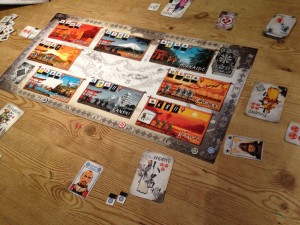 Shitenno is designed by Cédric Lefebvre whose previous games (Yggdrasil and Offrandes) have been really good. Shitenno is a game set in feudal Japan which mixes a you-cut-I-decide mechanic with area control. Each round, 2 troop cards and 1 income card per player are drawn face-up – the first player in turn order is the Tairo who selects any number and mix of the cards and offers them to the other players (in turn order) along with one of the 4 role cards. A player can accept or refuse the offer – if a player accepts, they take the cards and role and can not accept any more cards that round, then the Tairo selects a new mix of cards and a role to offer to the remaining players who have yet to accept an offer that round. If no other player accepts an offer, the Tairo must take the cards and role themselves (and the next player in turn order who has not accepted an offer becomes the Tairo).
Shitenno is designed by Cédric Lefebvre whose previous games (Yggdrasil and Offrandes) have been really good. Shitenno is a game set in feudal Japan which mixes a you-cut-I-decide mechanic with area control. Each round, 2 troop cards and 1 income card per player are drawn face-up – the first player in turn order is the Tairo who selects any number and mix of the cards and offers them to the other players (in turn order) along with one of the 4 role cards. A player can accept or refuse the offer – if a player accepts, they take the cards and role and can not accept any more cards that round, then the Tairo selects a new mix of cards and a role to offer to the remaining players who have yet to accept an offer that round. If no other player accepts an offer, the Tairo must take the cards and role themselves (and the next player in turn order who has not accepted an offer becomes the Tairo).
Once each player has accepted some cards (the final player to accepts all that remains), the players now claim areas in turn order which is dictated by the role cards they received (and the roles also give other special abilities too).
The board has 8 regions and spaces for 4 control markers in each (which I shall call zones). Players get points for placing a control marker in a zone equal to the number printed on the zone – the zones must be claimed in order and players get more points the later they claim a zone in a region. The zones in some regions score more points than others, but these take more cards to claim them. As well as points for claiming zones, players will score extra points at the end of the game if they have the most control markers in a zone (with ties being split by whoever was there earliest). Read the rest of this entry »
Tags: board game news, Board Games, board gaming, Shitenno
Posted in Board Game Review, Board Games, Shitenno | No Comments »
Posted by James (admin) on 12th September 2012
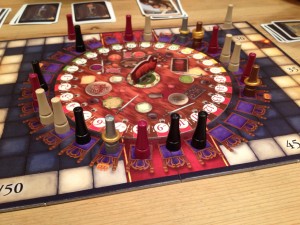 Artus is a game about King Arthur and the round table designed by Michael Kiesling and Wolfgang Kramer (the creators of great games such as Tikal, Tikal II and Asara). The board shows the round table with seats around the outside occupied by players’ knights, the princes and the king. The table shows points values ranging from -15 to +10 for each seat position. The crown on the table always points at the King, so when the King moves, the table turns which means the points for each chair change.
Artus is a game about King Arthur and the round table designed by Michael Kiesling and Wolfgang Kramer (the creators of great games such as Tikal, Tikal II and Asara). The board shows the round table with seats around the outside occupied by players’ knights, the princes and the king. The table shows points values ranging from -15 to +10 for each seat position. The crown on the table always points at the King, so when the King moves, the table turns which means the points for each chair change.
Each player has 22 cards (all will be played during the game) which are split into 3 decks and each player has the same: Knight cards move your own knights, King cards move the King/Princes, and scoring cards. Players start with 3 Knight and 3 King cards, but after their first turn, they can draw cards from any of their decks.
On their turn, players play any 2 of their 6 cards. Knight cards let the player move one of their knights a number of spaces within its range so a 3-6 Knight card lets you move one knight 3, 4, 5 or 6 spaces. Knights move clockwise apart from one card that lets you move one anti-clockwise. When a knight moves, the player scores points equal to the value of the chair (indicated by the table) that they vacate. If a knight moves to a chair already occupied by a knight then that knight gets displaced to the first empty chair anti-clockwise. Read the rest of this entry »
Tags: Artus, Asara, board game news, Board Games, board gaming, Michael Kiesling, Tikal, Tikal II, Wolfgang Kramer
Posted in Artus, Board Game Review, Board Games | No Comments »
Posted by James (admin) on 7th September 2012
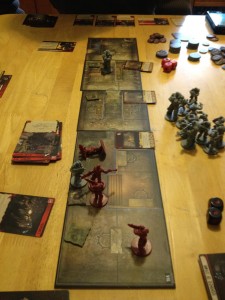 Gears of War is first-person shooter game on Xbox. The board game by Fantasy Flight Games had been listed as in-development for several years so it was interesting to finally get it play it. The video game focusses on a small squad of human soldiers (called COG) fighting against an alien race – a lot of the main action involves frantic gunfights, dashing from (or diving over) cover whilst under (and returning) heavy gunfire, and often throwing grenades into large holes in the ground where the enemies are emerging from.
Gears of War is first-person shooter game on Xbox. The board game by Fantasy Flight Games had been listed as in-development for several years so it was interesting to finally get it play it. The video game focusses on a small squad of human soldiers (called COG) fighting against an alien race – a lot of the main action involves frantic gunfights, dashing from (or diving over) cover whilst under (and returning) heavy gunfire, and often throwing grenades into large holes in the ground where the enemies are emerging from.
The board game of Gears of War has all the players playing the COG soldiers co-operatively against the game (enemy) and there are various scenarios which determine the map, victory conditions, etc. Also, some scenarios have multiple stages and the players must complete one stage before they next is revealed. The map is made of various tile sections and each is divided into several areas which determine movement and weapon range.
Each player has a hand of Order cards (gaining 2 at the start of each turn) which each describe a special action but also act as the player’s health too. Every turn, players play a card to perform the card’s action (like move 4 spaces and attack, revive a comrade, etc.), or to move 2 spaces, or to do 1 standard attack. Each card also has 1 of 3 icons which mean it can be played when it is not the player’s turn to either attack an enemy, gain extra defence dice, or move with a comrade. If a player runs out of cards, they are ‘bleeding out’ until a comrade revives them, which means they can crawl 1 space per turn, don’t get attacked, and gain no cards. Read the rest of this entry »
Tags: board game news, Board Games, board gaming, FFG, Gears of War
Posted in Board Game Review, Board Games, Gears of War | No Comments »
Posted by James (admin) on 4th September 2012
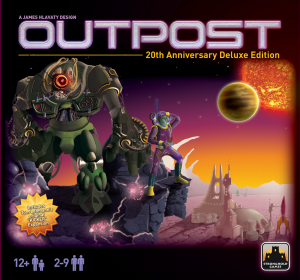 Outpost is a futuristic economic game set in space which is richer than it may first sound. The game ends as soon as one player has gained 75 victory points (VPs) or more, and the winner is player with the most VPs at the end of that round.
Outpost is a futuristic economic game set in space which is richer than it may first sound. The game ends as soon as one player has gained 75 victory points (VPs) or more, and the winner is player with the most VPs at the end of that round.
Player start with some ore mining facilities and a few human colonists to run them. During the game, players will build new (and usually better) production facilities and will gain technologies and more colonists too. The golden rule is (apart from one exception) if you don’t have colonists (or robots) to run a production facility, it is not ‘manned’ so does not produce anything and is worth 0 VPs. Each player has their own player board which shows their current VPs, maximum number of human colonists, and the maximum hand size (cards).
At the start of each round, players draw income cards – one for each staffed production facility. There are different decks for each type of facility and the cards say how many credits of income they have generated. For example, the Ore Mining cards are the least valuable with an average value of 3 credits; whereas, the next better facility is Water Production whose cards are worth an average of 7 credits each. (The best facility’s cards have an average value of 5o credits!) However, the better facilities cost more to build, and many have restrictions and/or require technologies too. This is a nice game mechanic as you know roughly what income you’ll get, but there’s still some randomness too. Read the rest of this entry »
Tags: board game news, Board Games, board gaming, Outpost
Posted in Board Game Review, Board Games, Outpost | No Comments »
 I like the idea of using poker hand mechanics in a game. At Spiel 2011, I played a game that used poker hands but it turned out to be average so I was really intrigued when, just 5 minutes later, I noticed Montana on the Cambridge Games Factory. With a cheap price, I decided to pre-order it and it arrived a couple of months ago.
I like the idea of using poker hand mechanics in a game. At Spiel 2011, I played a game that used poker hands but it turned out to be average so I was really intrigued when, just 5 minutes later, I noticed Montana on the Cambridge Games Factory. With a cheap price, I decided to pre-order it and it arrived a couple of months ago.









